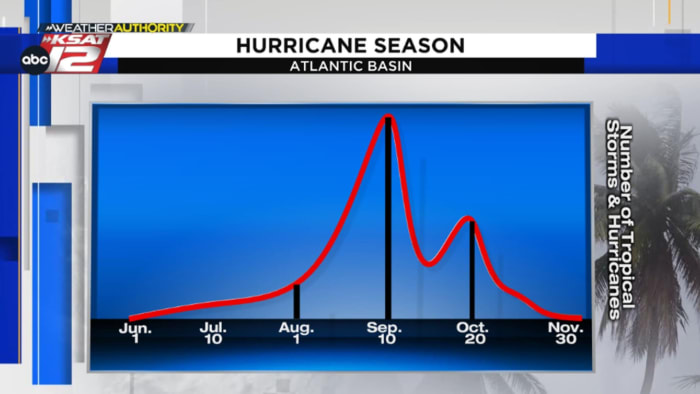
Saturday, June 1, officially marks the start of the 2024 Atlantic hurricane season. Here’s the latest outlook on the months ahead:
KEY POINTS
-
The Atlantic hurricane season runs from June 1 through November 30.
-
Forecasters at both NOAA and Colorado State University are calling for an above-average season.
-
Factors like La Niña, near-record warm ocean temperatures, an active African monsoon, and lower wind shear in the Atlantic contributed to these active forecasts.
-
An above average season doesn’t necessarily mean that a higher-than-normal number of storms will directly impact the United States.
-
Still, it’s best to stay prepared and remain weather-aware over the next several months.
2024 NOAA Forecast Outlook
The National Oceanic and Atmospheric Administration is predicting an “above-normal” season, forecasting the following numbers:
-
Named Storms: 17-25
-
Hurricanes: 8-13
-
Major Hurricanes (Category 3 or Higher): 4-7
2024 Colorado State University Forecast Outlook
Forecasters at Colorado State University are also calling for an active season, releasing the following numbers:
-
Named Storms: 23
-
Hurricanes: 11
-
Major Hurricanes (Category 3 or Higher): 5
For context, the average number (taken from the 1991-2020 period) of named storms is 14, with 7 becoming hurricanes and 3 becoming major hurricanes.
The Science Behind the Forecast
Scientists cite that several factors contributed to this “above-normal” forecast:
-
Near-record warm ocean temperatures
-
Lowered trade winds
-
Less wind shear
-
Active African monsoon
La Niña often leads to lower wind shear in the Atlantic Basin and Caribbean, which can support tropical cyclone development and sustainability in comparison to El Niño years. At the same time, warm ocean temperatures serve as more fuel for storm development, while light trade winds can help hurricanes grow.
The active African monsoon will likely lead to more waves of energy coming off the coast of Africa, which would serve as a base to get a tropical cyclone up and running, especially under these conducive environmental conditions.
2024 Tropical Cyclone Names – Atlantic Basin
A tropical system isn’t given a name until it strengthens into a tropical storm. The first name up for grabs on the list for this year will be Alberto.
Here’s the official list of tropical cyclone names for the upcoming season:
Stay Prepared
When this time of year rolls around, it’s important for those along and near coastal areas to always be prepared.
Closer to San Antonio, we rarely see devastating direct impacts of destructive winds and storm surge from tropical systems.
If a tropical storm does makes landfall along the Gulf Coast and heads our way, it usually just means increased rainfall, cloudier skies, and cooler temperatures — especially if the tropical storm is unorganized and weak.
Still, all it takes is one storm to make a significant impact. To stay prepared, it’s best to keep an at-home kit ready that includes important items such as water, a first aid kit, toiletries, and non-perishable food items.
Also stay up to date with your insurance policies and check back in on the forecast regularly over the next few months.
Your Weather Authority will keep you updated!
The Atlantic hurricane season starts on June 1, peaks on Sept. 10, and ends on Nov. 30.
Read more from the meteorologists on the Whatever the Weather page
Download KSAT’s weather app for customized, accurate forecasts in San Antonio, South Texas or wherever you are
Find the latest forecasts, radar and alerts on the KSAT Weather Authority page
Original News Source
Click here for San Antonio HOA Management
